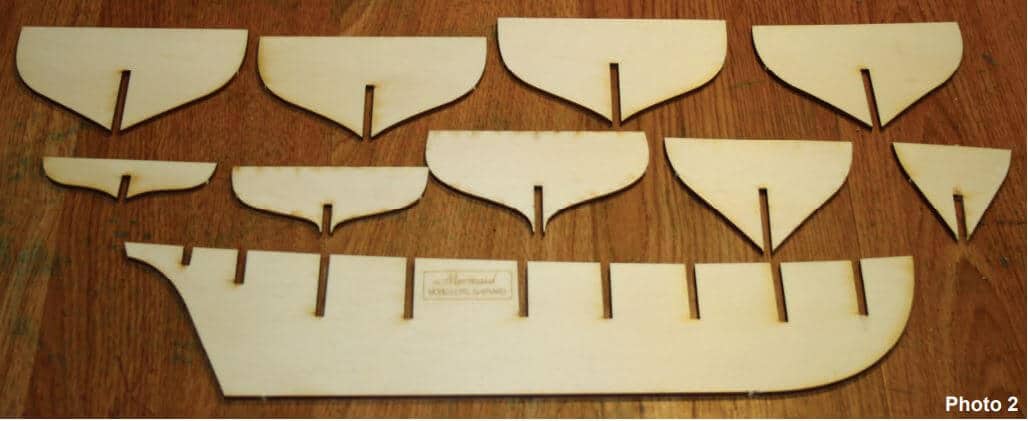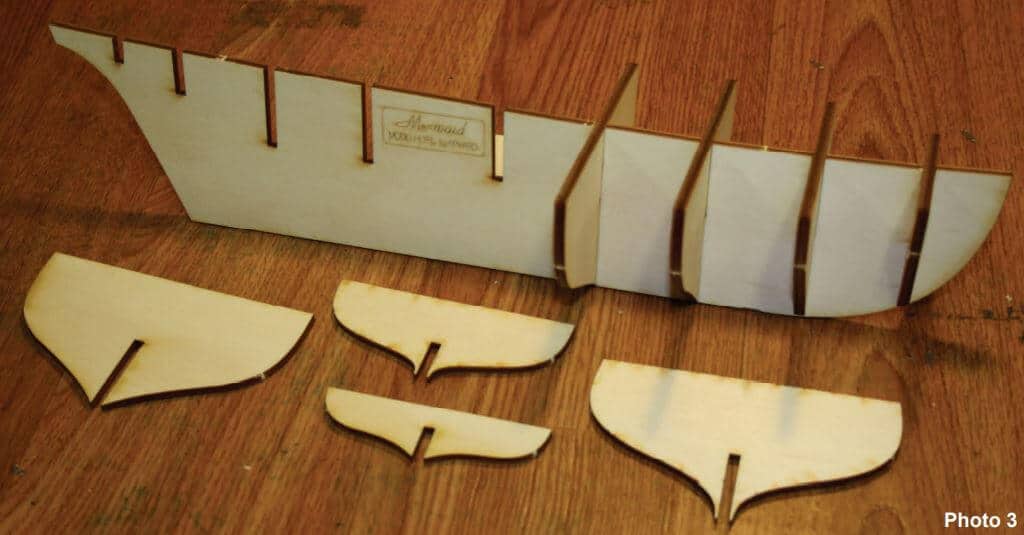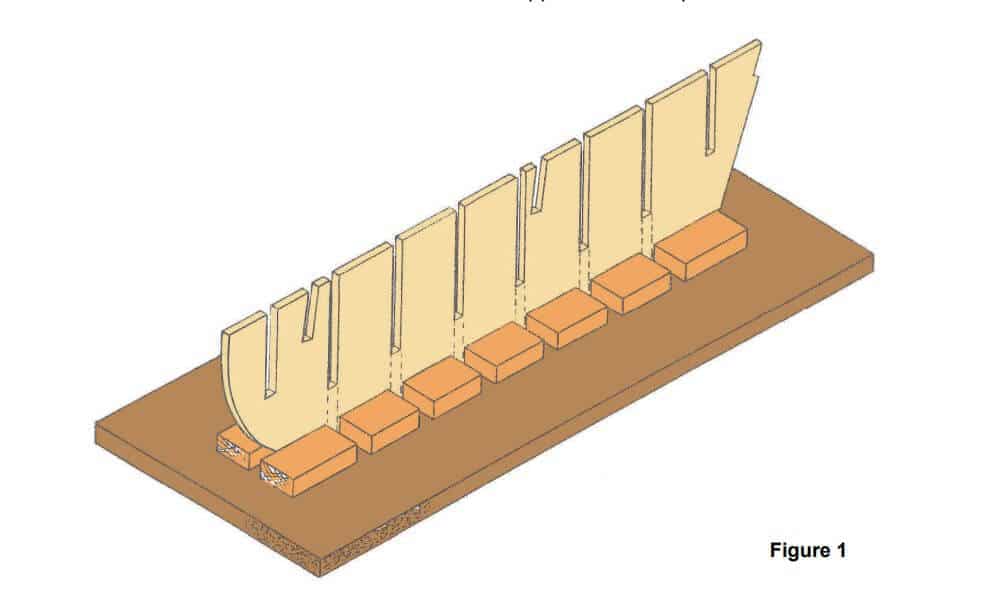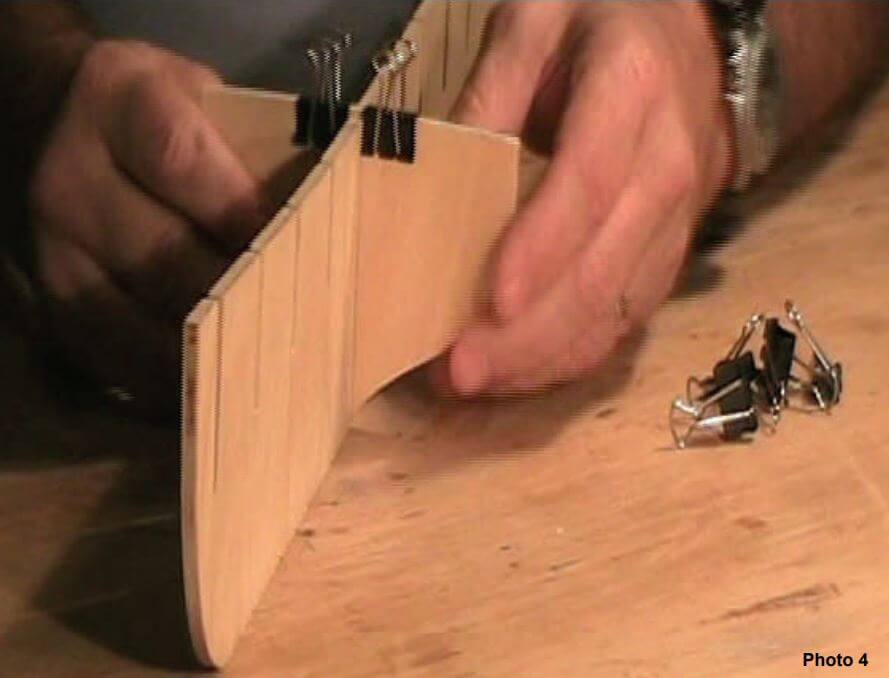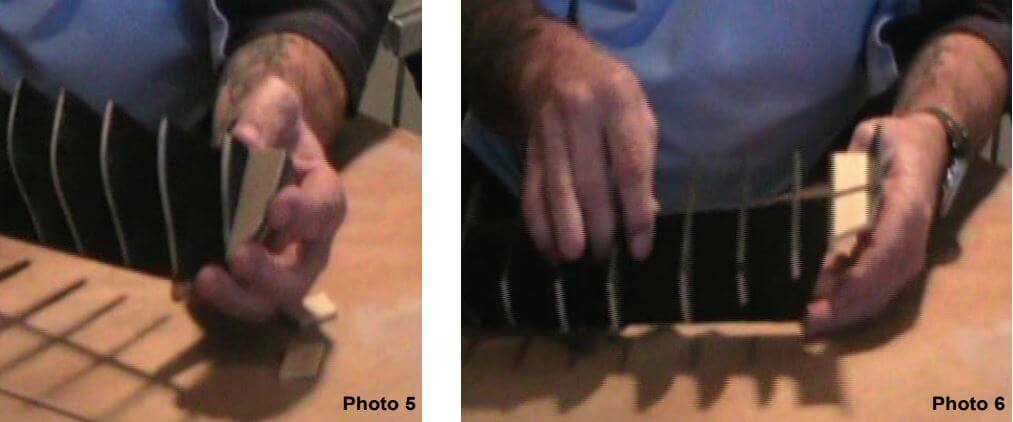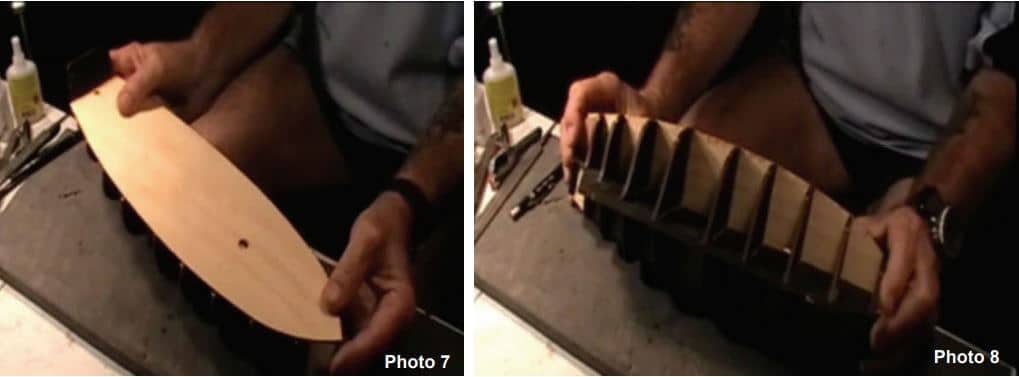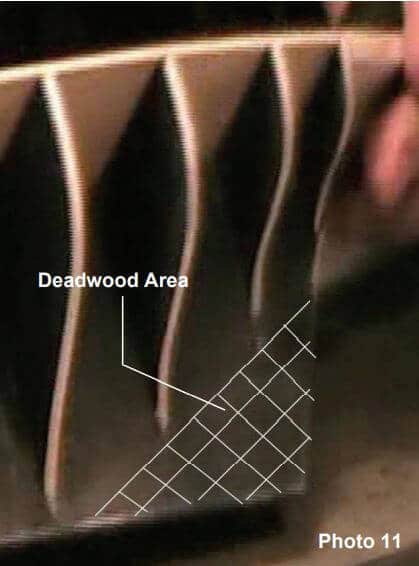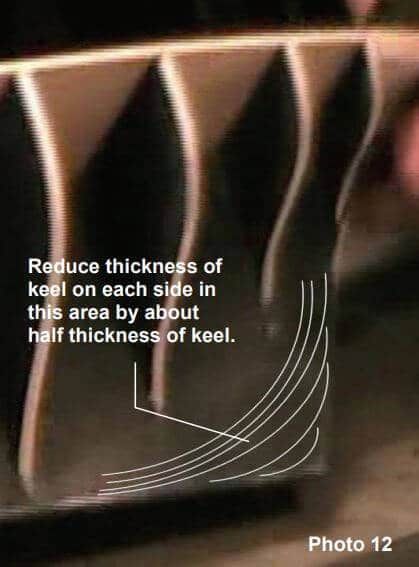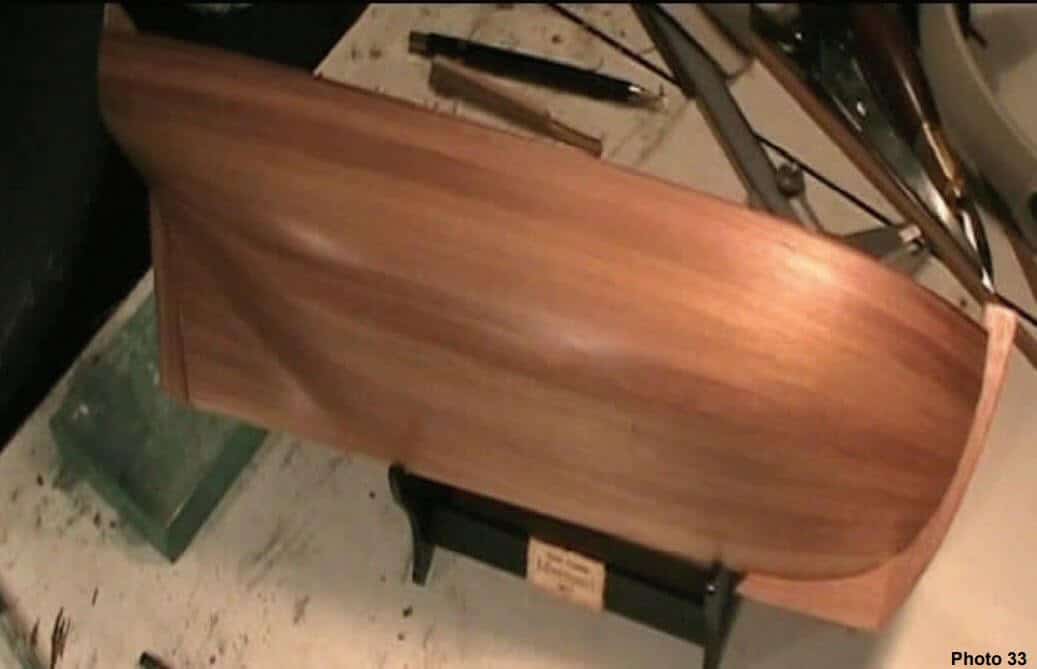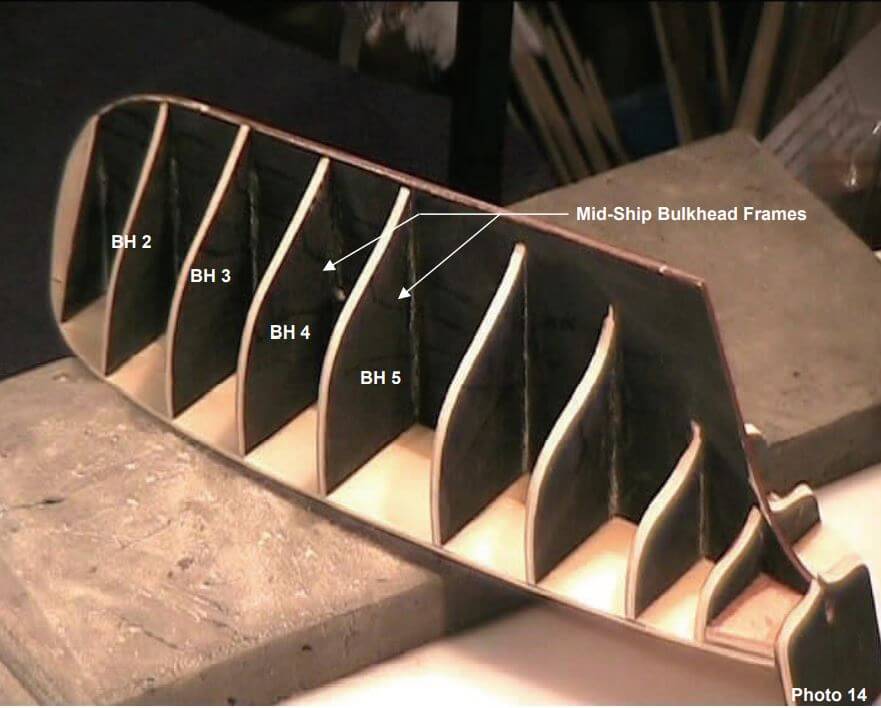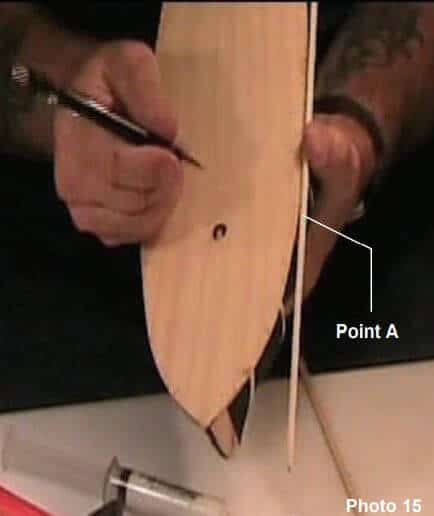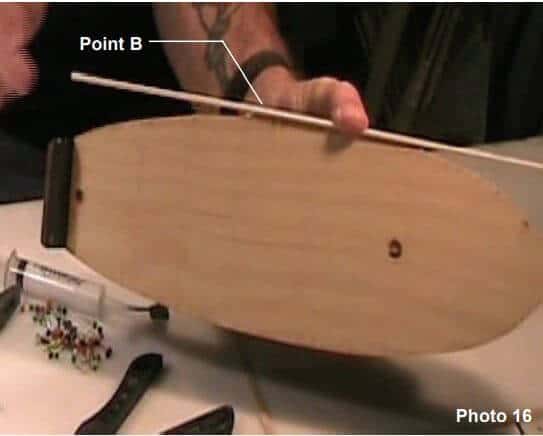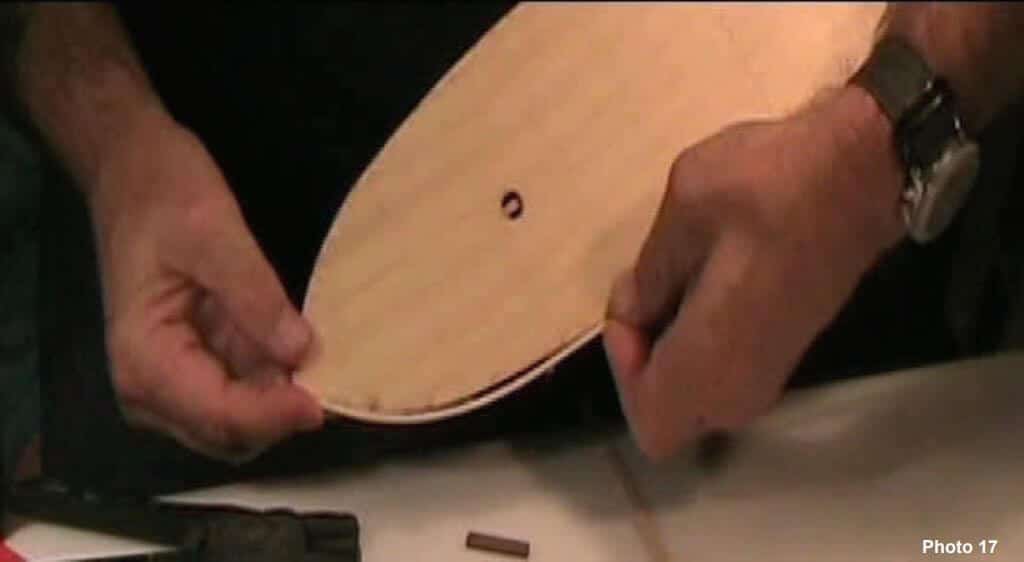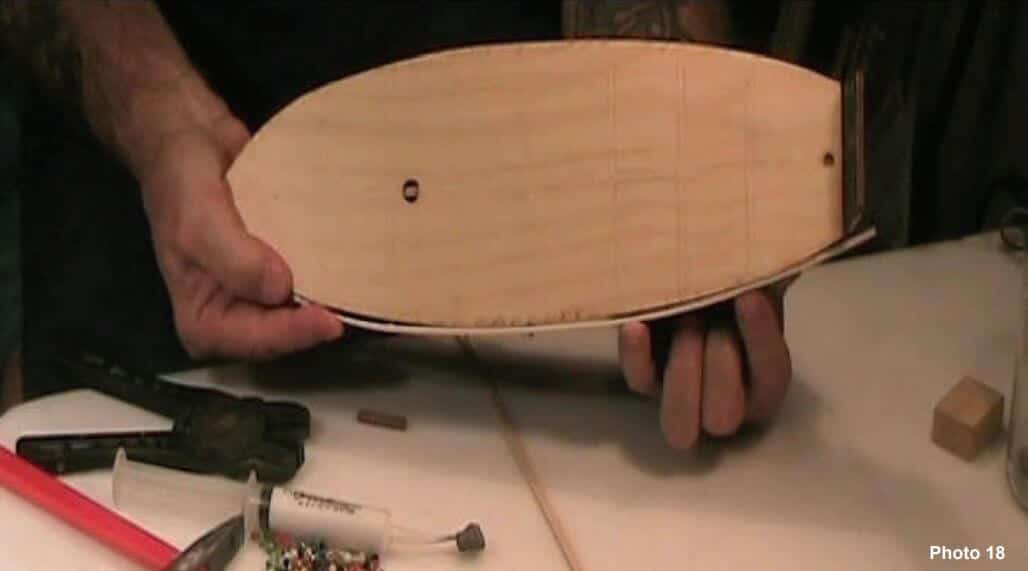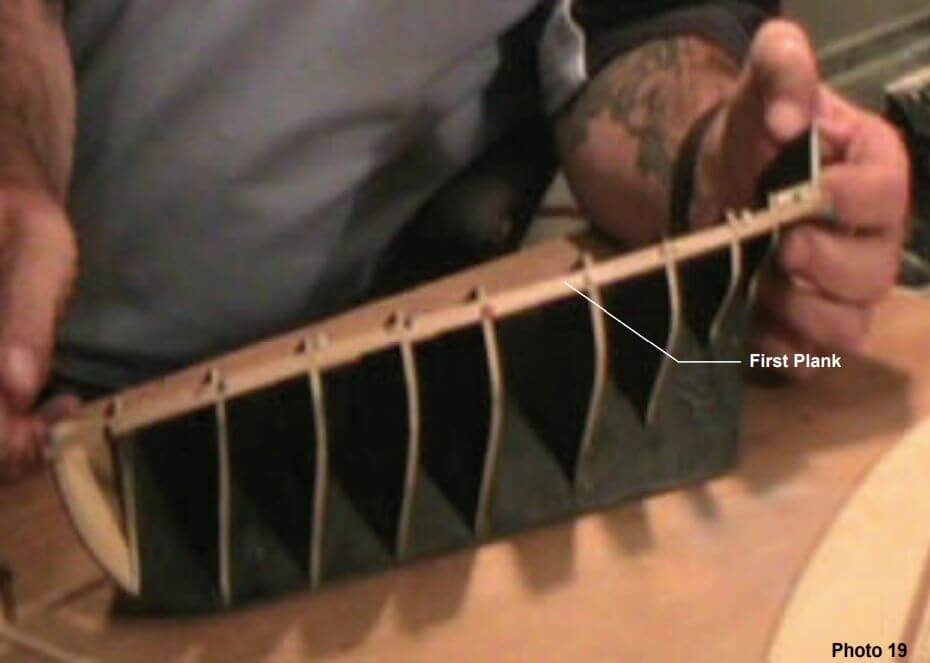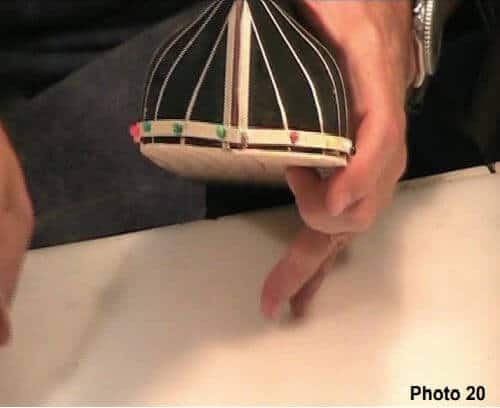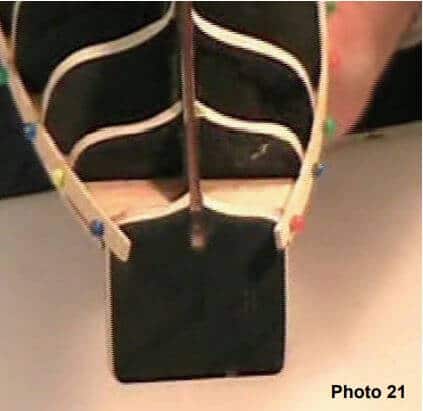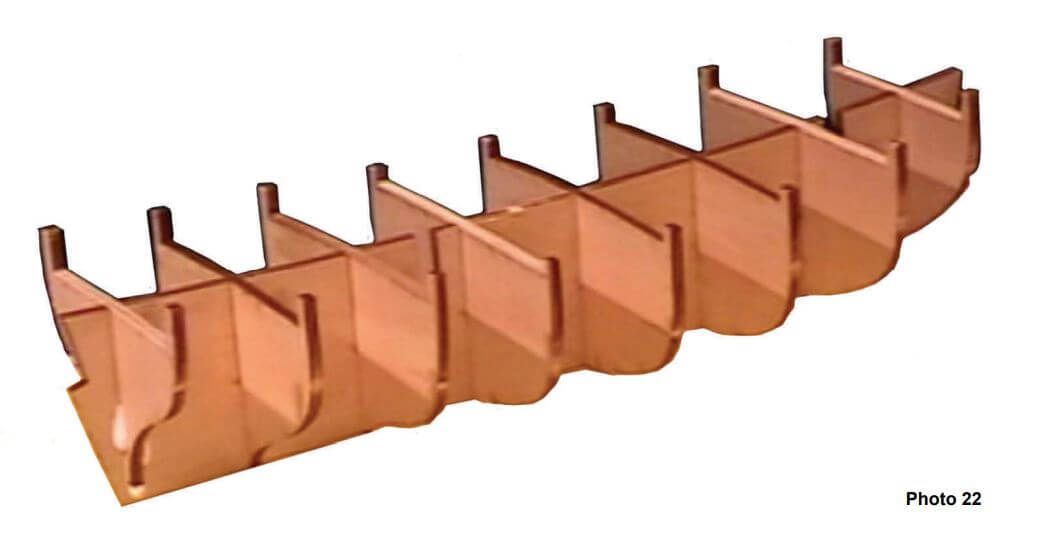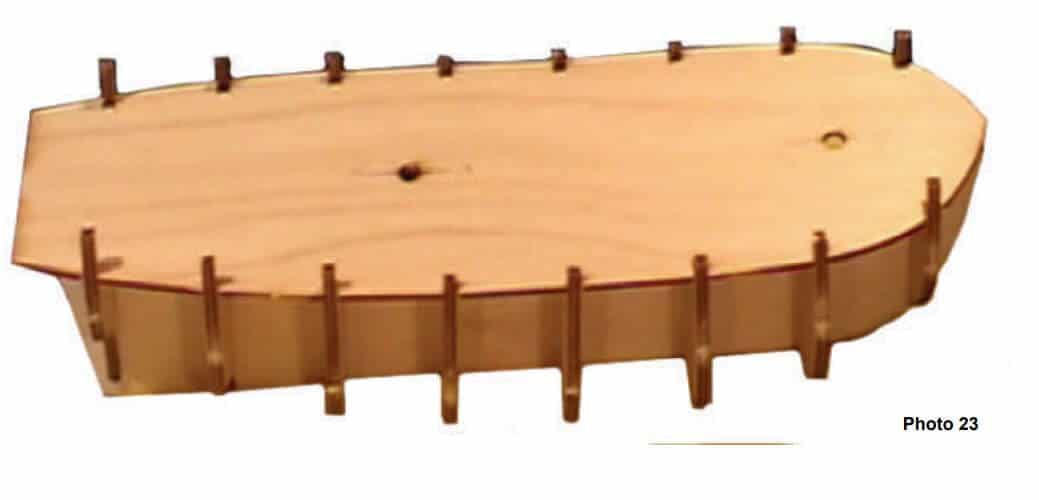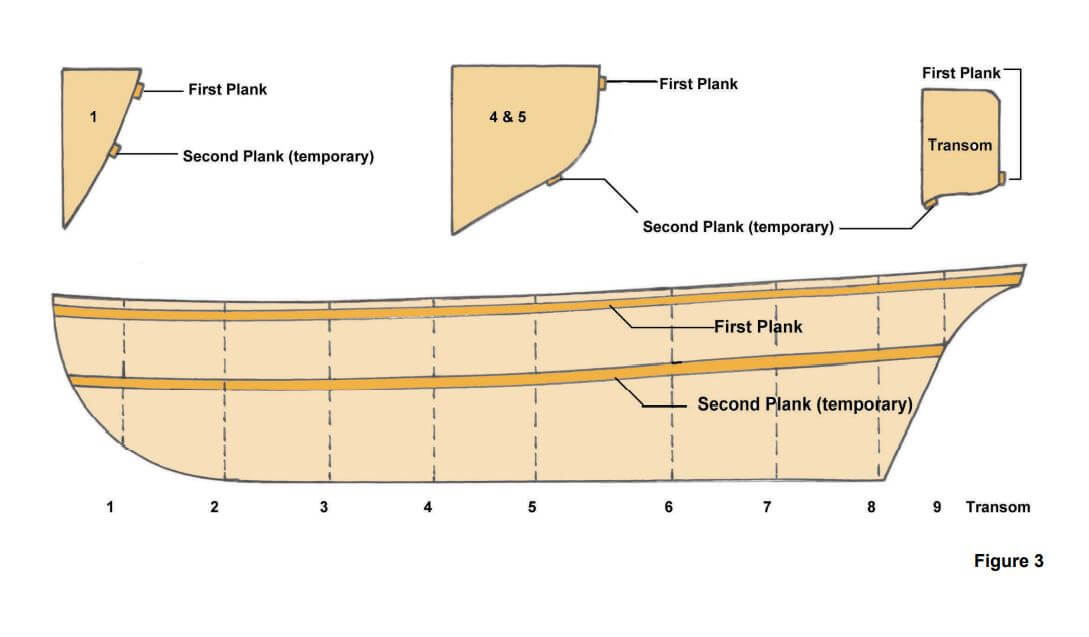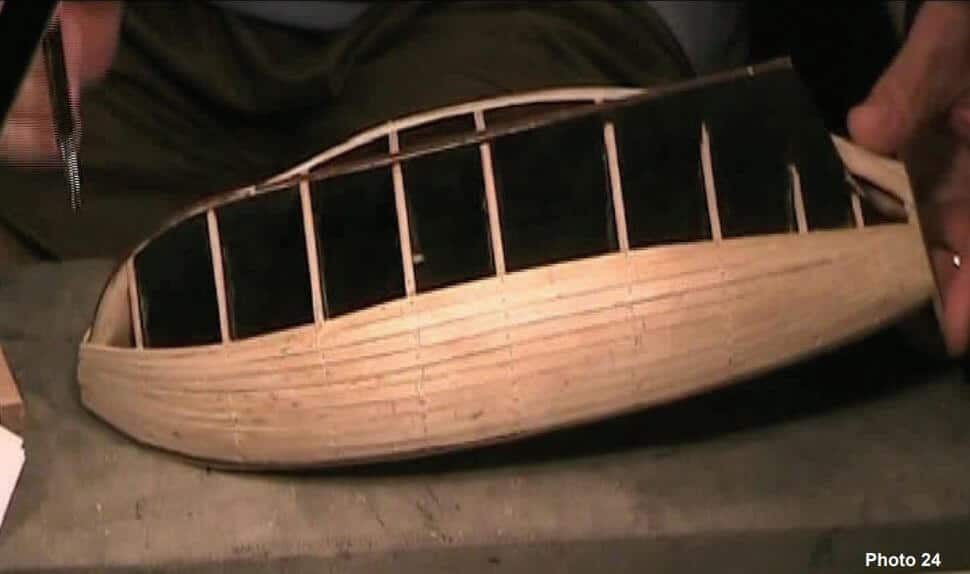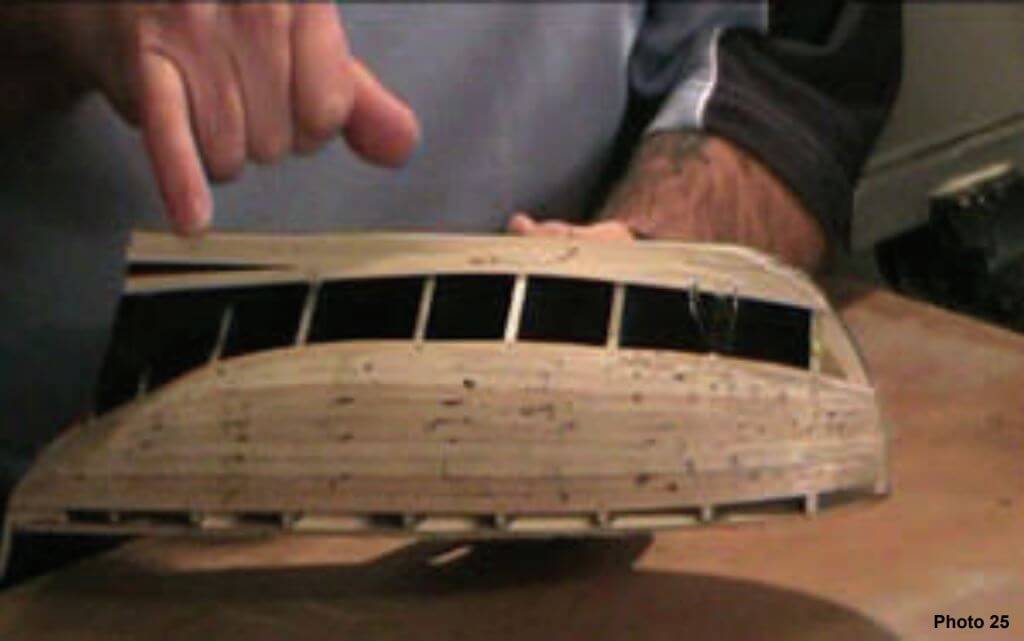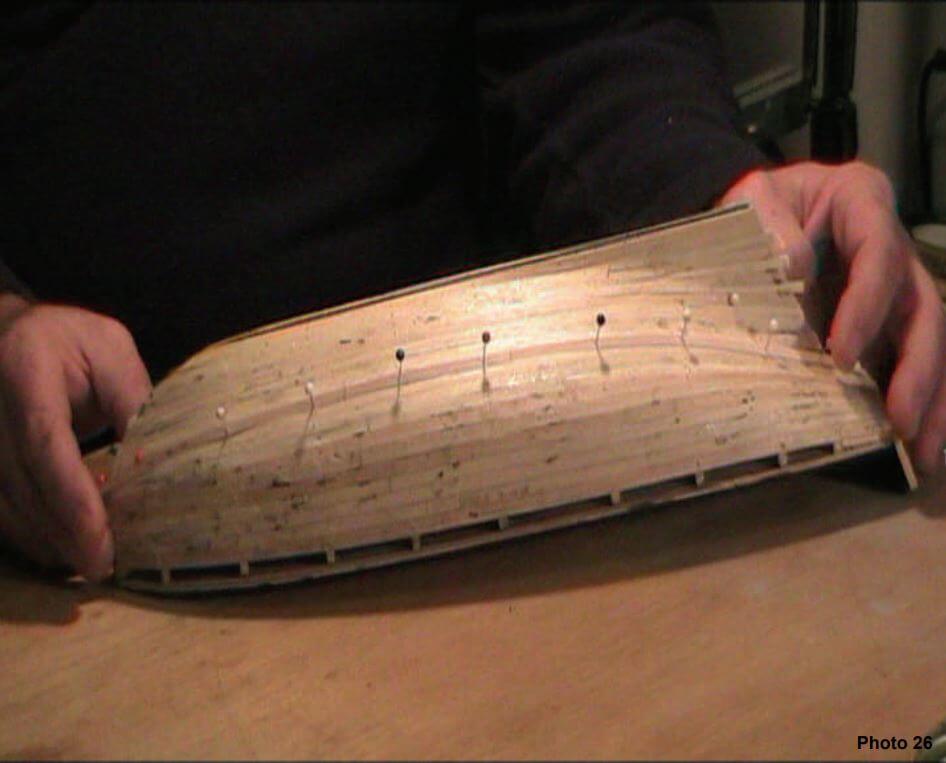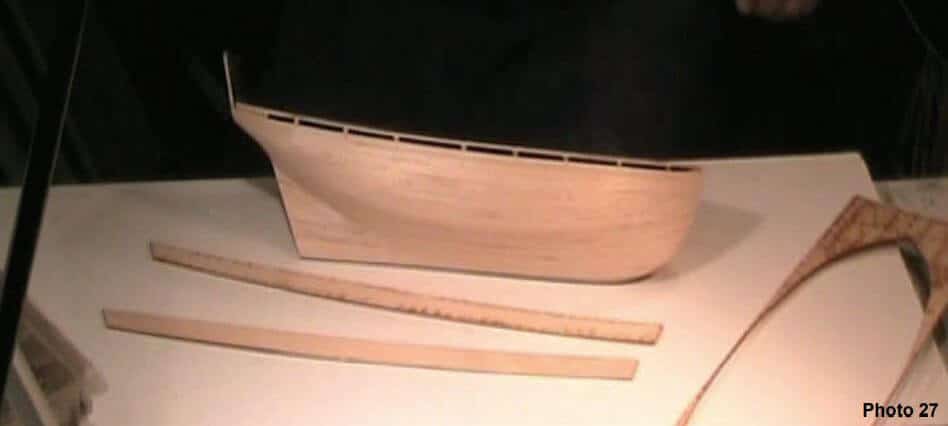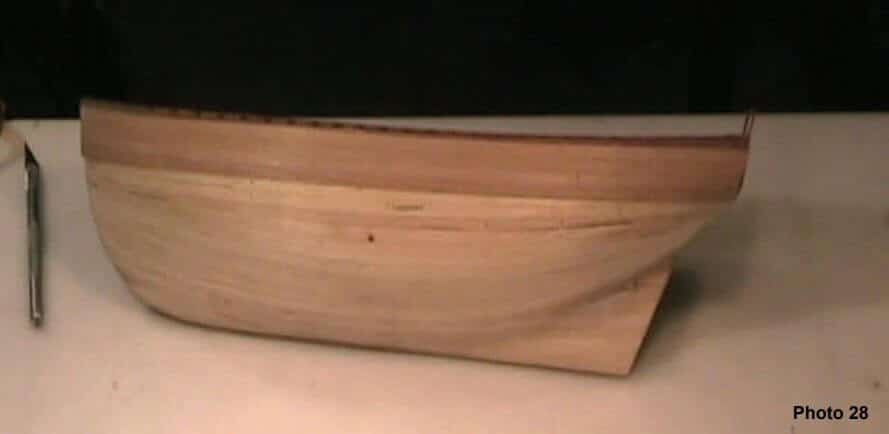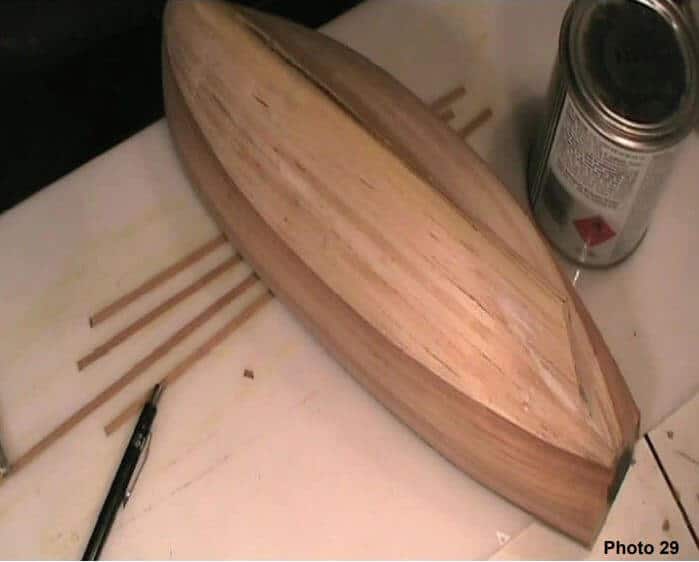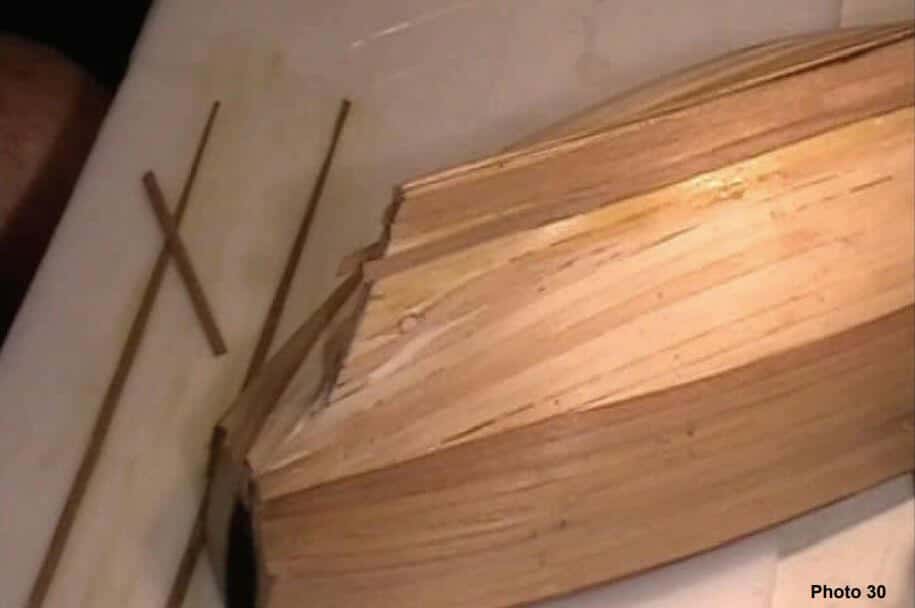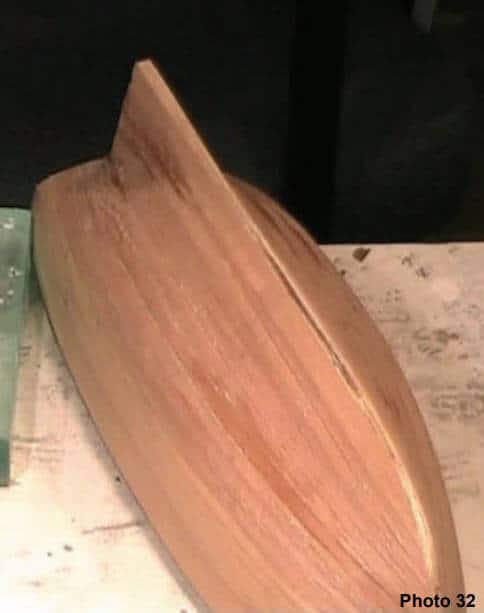How To Plank The Hull of a Sharp Bow Model Ship
- Updated on:
- Written by Gary Renshaw
Learn How To Plank The Hull of a Sharp Bowed Wooden Model Ship with this Comprehensive Build Guide From Modelers Central.
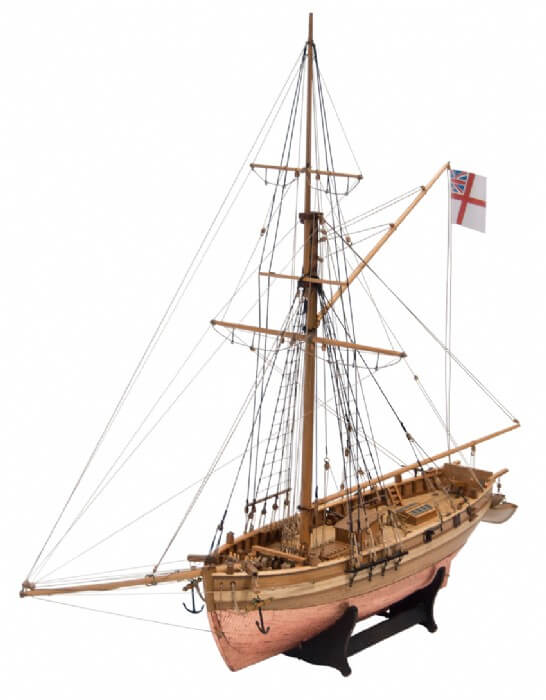
Hull Planking—Sharp Bow
The hull is the single largest part of a model ship. Building the hull correctly will determine the final shape and appearance of the model. In your kit you will find a number of plywood sheets with the laser cut parts. Use the kit’s plans and instructions to identify and number each part on the plywood sheets with a pencil. Do this before removing any parts from the plywood sheet.
Constructing the Hull
To construct the hull follow these steps.
Step 1 – In the kit there will be a 4mm thick plywood sheet as shown Photo 1 below. On this sheet there will be a number of parts for the model. The keel, bulkheads and transom are the parts needed to construct the hull. When fitted and glued together these parts form the skeleton of the hull. The keel, bulkheads (BH) and transom are identified in Photo 1.
The keel is the ship’s main structural piece. It runs longitudinally down the centre of the model from the stem (or bow) – front—to the stern—the rear—of the model. The keel is the centre piece of the model and everything is built from it.
The bulkheads are fixed at right angles to the keel and provide strength to the hull. Throughout this course we will refer to the bulkheads as bulkhead frames.
The transom is fixed at right angles to the keel and sits at the stern. The transom is not a bulkhead but does form part of the hull construction.
Step 2 – Remove the keel, bulkhead frames and transom from the 4mm plywood sheet. Use a snap blade knife to carefully cut through the tabs holding the parts to the main sheet.
Step 3 – Dry fit the bulkhead frames into the keel slots. Do not glue anything at this stage. Do not force the bulkhead frame into the keel slot. You may need to use a flat needle file to fractionally open the slot in both the keel and bulkhead frame. The fit should be firm but no loose.
There may be a need to adjust the slot depth in the keel and/or bulkhead frames to ensure the top edge of each bulkhead frame is flush with the top edge of the keel. Do not glue anything at this stage.
Step 4 – For larger models it is wise to make a working base as shown Figure 1. This will help to ensure the keel does not become distorted. Cut the slots in the keel supports to correspond with the bulkhead frames.
Step 5 – It is very important to ensure the bulkhead frames are fitted and fixed square to keel. Use “bull dog” clips placed on the keel and up against the bulkhead frame to hold the bulkhead square to the keel while the glue sets.
Step 6 – The next step is to fit any bow blocks and stern blocks if the model has them. Both of these parts will be on the 4mm plywood sheet.
The bow blocks are fitted and glued in place either side of the keel at the bow and in front of the first bulkhead frame—see Photo 5. These blocks will provide a larger surface area on which to fix the planks at the bow.
The stern blocks are fitted and glued in place either side of the keel at the stern between the last bulkhead frame and the transom—see Photo 6. These blocks are used to provide a larger surface area on which to fix the planks at the stern and give added strength to the stern area.
Step 7 – The next step is to fit and fix the false deck to the hull skeleton. The false deck is part of the 2mm plywood sheet.
Fitting the false deck at this stage will provide added strength to the whole hull structure.
On some models the false deck is fitted later
Step 8 – Fairing the Bulkhead Frames
After the bulkhead frames have all been squared to the keel and glued in place and the glue has set it is now time to prepare the bulkhead frames for planking.
Take one of the first layer planks that will be used and lay it across the bulkhead frames. You will see that at the bow the plank does not touch the full face of the bulkhead frame—see Photo 9. The same is the case at the stern—see Photo 10. Across the mid-ship bulkhead frames the plank will lay flat on the bulkhead frames.
It is most important that the planks lay flat on the full face of each bulkhead frame to firstly, allow a strong bond between planks and bulkhead frames to be made and secondly, to ensure there are no bumps or hollows in the hull surface when planked.
The tools you will need to prepare the bulkhead frames for planking are a good file—one face flat and the other face half round and a sanding block (block of wood with coarse sandpaper glued to it).
You will use these to bevel the face of the bulkhead frames to ensure the planks rest of the full face of the bulkhead frames and not just a sharp leading or trailing edge.
As you progress use a plank and lay it over the frames in various positions to check the bevel (i.e. the plank should touch the full face of each frame as it is bent around them). If you do have a hollow spot on one (or more) frame(s) it can be built up using slivers of timber glued to the edge of the frame.
The whole process of bevelling and checking is known as “fairing” and is extremely important to ensure that when planked, the hull is free of bumps and hollows. Take your time and resist the temptation to start planking before the hull is satisfactorily “faired”.
It cannot be emphasised too strongly that the fairing process is the single most important step in building a model ship of which you’ll be proud. Take your time with this process.
We will now consider the shaping of the deadwood area.
Step 9 – Deadwood Area
The next step to consider is the keel at the stern. Pay particular attention to this area. The total thickness of this area must be such that when planked with all layers of planking it is the same thickness at the stern post and rudder.
Deadwood Area is the area between the bottom edge of the keel and the bottom of the bulkhead frames at the stern is known as the deadwood area—See Photo 11.
Depending upon the type of ship that is being modelled the deadwood area may be small or large.
The deadwood area will be planked with two layers of planking consistent with the rest of the hull.
The stern post and rudder however will only be planked with the second layer of planking. So when the stern post and rudder are eventually fitted there is the need to ensure there is a consistent thickness between stern post, rudder and the stern area of the keel.
For example, the keel, stern post & rudder will all be taken from the 4mm plywood sheet.
The stern post and rudder will be planked with the second layer of planking —say 0.6mm walnut. However the keel will be planked with the first layer of planking—say 2mm thick (on each side) and then planked with the second layer of planking. Clearly, when the stern post and rudder are fitted there will be a significant discrepancy between the thickness of the stern area of the keel and the stern post and rudder.
To ensure there is consistency of thickness between the stern post, rudder and hull in this area there is the need to ensure that when the first layer of planking is fixed in place the total thickness does not exceed the thickness of the stern post/rudder post.
To achieve this you will need to take two steps.
Step 1. Before fitting the first layer of planking reduce the thickness of the keel in the area by approximately 1mm on each side—reduce the keel thickness by about half.
Step 2. Once the first layer of planking has been fitted then reduce the thickness of this planking by approximately 1mm on each side as well—fractionally adjusting to meet required thickness.
This will then reduce the total thickness of the keel and first layer of planking in the area to be 4mm thick and thus meeting the requirement for consistency of thickness so that when the second layer of planking is fitted there will be consistency of thickness between the keel and the stern post and rudder.
Planking the Hull
We will now turn to focus on the principles of planking the hull of a sharp bow model. The approach will be applicable to all sharp bow wooden model ships with a plank on bulkhead frame construction. There are many approaches to planking the hull of a wooden model ship. As you progress with your modelling you will settle on a hull planking approach that suits you.
Planking the hull is not technically difficult but it does require some thought and study so that the principles are understood. It also requires some patience. Once mastered the process is straightforward.
There are a few points to remember:
- Use a mini plane to taper the planks.
- Always taper the lower edge of the plank—ie the edge that will be closer to the keel.
- Prepare two planks together—one for each side of the hull. It is most important to fit and glue the planks in pairs—one on each side of the hull as this will minimise the chance of the keel being distorted or bent.
Planking—First Principles
On the model you are building spend a few moments with a dressmakers tape measure and measure from the top of the each bulkhead frame around the outside of the frame to the toe of the bulkhead frame where it meets the keel. You will notice that the measurements around the bulkhead frames in the middle or “mid-ship” of the model are greater than the measurement around the bulkhead frames at the bow (front) of the model.
We always assume that the “mid-ship” bulkhead frames are the largest distance and it is at this part of the model the planks will be at their full width.
From your measurements it will be clear that if you are to fit one plank along the full length of the hull you will need to taper the planks that fit across the bulkhead frames at the bow of the model.
We will now consider this further with a few examples.
Mid-Ship Bulkhead Frames
It is assumed that the planks laid across the mid-ship bulkhead frames are at their maximum width. We need to determine how many planks will fit into the area between the top of these bulkhead frames and the keel.
As an example let’s say the measurement from the top of the mid-ship bulkhead frames 4 & 5 to the keel is 120mm.
Question: If the width of the planks we are using is 5mm then how many planks will fit across the midship bulkhead frames to cover it completely?
Answer: If the measurement is 120mm and the width of the planks to be used is 5mm then divide 120mm by 5mm that is 120/5 = 24 planks will be needed to fit into the area. These planks laid across the mid-ship frames will not be tapered or reduced in width across these bulkhead frames.
Fore Bulkhead Frames
Now let’s say the measurement from the top of the bulkhead frame 2 to the keel is 80mm. As 24 planks will have to fit into this area then the plank width at bulkhead frame 2 will need to be reduced. The question is what will the width of each plank have to be to fit 24 planks into this area?
Question: What is the plank width needed at bulkhead frame 2 if 24 planks have to fit into the area?
Answer: If the measurement is 80mm—then divide 80mm by 24 planks that is 80/24 = 3.33mm. So the plank wide at bulkhead frame 2 needs to be 3.33mm to ensure that 24 planks will fit into this area.
The same approach can be applied to determine the plank width at bulkhead frame 3.
Stern Bulkhead Frames
You will recall that the area between the bottom edge of the keel and the bottom of the bulkhead frames at the stern is known as the deadwood area.
When making your measurements of these stern bulkhead frames include the “deadwood” in your measurement.
Across these bulkhead frames you will find the measurement from the top of the bulkhead frame to the bottom of the keel will be greater than it is at the “mid-ships” bulkhead frames. Where this occurs you will be inserting short triangular planks known as “Stealers” or “Wedges” to cover the extra distance. The use of stealers or wedges will be dealt with later.
Fitting the First & Second Planks
We will now focus on applying the principles of hull planking.
First Plank
Determine from the plans and/or the written kit instructions the position of the first plank(s). In “real” shipbuilding it was usual to start planking at the keel and work upwards. However, in model ship building we usually start the first plank in one of three positions:
1. With a ship that has a “flush” or straight upper deck, such as “Bounty” or “Port Jackson” then the first plank is laid with its upper edge level with the deck surface. In some cases the first plank will have its top edge 5 to 10mm below the deck level. This is done to facilitate the construction of bulwarks at a later stage but in any case, it will be parallel to the line of the deck.
2. In the case of those models in which the “upper” or “weather” deck is in either two or three distinct sections, at differing levels, then the first plank is commonly run along the line of the “middle” or “main” deck then follows its natural course both “fore” and “aft”.
3. Many models that feature below-deck open gunports, will require the first plank to follow the line of the gunports and it will run immediately above or below a row of gunports.
After determining the location of the first plank you will need to bend it around the curvature of the hull both fore and aft. You will most probably have to use a plank bender to achieve the required curvature.
Take one of the planks to be used and place it in position. Gently spring the plank around the bow. At the point where the plank starts to bend—mark this as point A—Photo 15.
Next, gently spring the plank around the stern. At the point where the plank starts to bend mark this as point B—Photo 16.
We are going to be very systematic in our preparation for planking.
Take another plank and transfer these two points onto it. On each plank mark an arrow pointing towards the bow. Also, mark each plank “P” for port (left) and “S” for starboard (right). We will do this for all the planks we prepare. We will also make all planks in pairs.
The first plank will not be tapered
From Point A use a plank bender to gently crimp the plank toward the bow—Photo 17. Trial fit the plank. If needed use the plank bender again by gently crimping between the previous crimps. This will increase the curvature of the plank. Repeat this process until you are satisfied with the plank curvature.
From Point B use a plank bender to gently crimp the plank toward the stern—Photo 18. Trial fit the plank. If needed use the plank bender again but gently crimp between the previous crimps. Repeat this process until you are satisfied with the plank curvature.
Now that you have shaped the first plank it is now time to fit it in position. Note again that the first plank will not be tapered.
Use PVA glue to fix the first plank in position—Photo 19. Make sure that both planks (left and right or “port” and “starboard”) follow the same line and are a mirror image of each other. In large models, the first two, three or four planks fitted are not tapered.
For the Mermaid the first plank is glued in and placed 4mm below the top of each bulkhead frame. This is done to allow a bulwark to be fitted later.
It is important to check that the first planks are symmetrical—check that they are a mirror image of each other at the bow and the stern—Photos 20 & 21.
Models with Bulkhead Frame Horns
Some models have bulkhead frames that rise above the deck level. These are called the bulkhead horns. If your model has bulkhead frame horns you will first need to fit the false deck before starting your planking. Fitting the false deck will add strength to the whole hull.
You will start to plank the hull at or near the deck level. However, once you have finished planking the hull below the deck you will need to plank above the deck line over the horns. You will need to remove the horns later to plank the deck fully so it is important to ensure that as you plank over the horns the planks are not glued to the horns. To ensure this you will need to place sticky tape over the horns. Also, as you plank up the horns make sure you apply glue to the side edge of the planks.
When the whole hull is fully planked you will use a razor saw pushed flush with the false deck to remove the horns. You can then prepare the false deck for planking—this aspect of model ship building is covered in the chapter on Deck Planking.
Photos 22 & 23 show a model that has bulkhead horns.
Fitting the Second Plank
The hull planking approach presented divides the hull into at least two areas. For large models, the approach can be used to divide the hull into three or more bands. Each band area is planked separately.
Follow the steps below to create the two planking bands.
Step 1: On the mid-ship bulkhead frames mark a position approximately halfway to the keel from the bottom edge of the first plank – the same distance down on each mid-ship bulkhead frame and a distance which is a multiple of a plank width. For example – if the planks are (say) 5mm wide then the distance down the edge of each frame to your pencil mark should be (say) 45mm or 50mm or 55mm etc., but the same distance on each mid-ship bulkhead frame.
Step 2: Take a second plank and temporarily attach it at the positions you just have marked on the mid -ship bulkhead frames – do not glue this plank in position. Repeat for the other side of the hull.
Step 3: Let this plank follow its natural course over the bulkhead frames to the bow and stern of the mid -ship bulkhead frames.
At the stern the plank will be terminated at the junction between the keel and transom. At the bow let the plank follow its natural course.
Step 4: Temporarily attach the planks to the rest of the frames making fine adjustments if necessary to ensure that each plank is a mirror image of the other.
Checking the corresponding measurements (port and starboard) on the first and last frames should show up any errors.
There are now four planks in place, two on each side of the hull—see Figure 3 below.
The hull have now been divided into two bands— an upper band and a lower band. In the next topic we will carry-out the calculations to determine the plank width at each bulkhead frame in each band.
First Layer of Planking
We will focus on applying the planking principles to complete the first layer of planking within the two bands created.
Band A
For the model you are building establish a table as shown below representing the number of bulkhead frames. You may also need to include the transom as well.
To determine the plank width at each bulkhead frame use a dressmakers tape measure to measure the distance between Plank 1 & Plank 2 at each bulkhead frame. Record these distances in your table— see Table 1 below which is for the Mermaid.
For the Mermaid the distance between Plank 1 & Plank 2 at the mid-ship bulkhead frames is 45mm. The plank width is 5mm. Therefore there will need to be 45/5 = 9 planks to be fitted within Band A.
Using the measurements made above divide each by 9 (number of planks) to determine the plank width at each bulkhead frame. Record in Table 1 below.
Take a pair of planks and taper them to the required width at each bulkhead using a mini plane. Use a plank bender to bend the bow and stern end of each plank. Note Points A & B are where bending is to start. Fit and glue in place these planks starting from the underside of the first plank.
A rule of thumb is that planks should not be tapered to more than half their width. However, there may be times when this rule can be extended to two-thirds of the plank width.
After fitting each pair of planks recheck the measurements to ensure the correct plank width. Adjust as necessary. Repeat this process until Band A is closed on both sides of the hull—Photo 24. Once Band A is closed remove the temporary planks.
Band B
The next step is to place the garboard plank in place. The garboard plank is the plank that is placed along the side of the keel. It is not tapered. However, it will need shaping at the bow to follow its curvature. Place another plank alongside the garboard plank and shape it as well.
Place a third plank alongside the second plank just fitted. At the stern allow this plank to follow its natural curvature over the deadwood area. You will see a gap will appear between this plank and the second plank fitted. A stealer or wedge will be used later to fill in this gap—Photo 25.
To fill in the remaining gap again establish a table as shown below for Band B. Repeat the process of taking measurements on each bulkhead frame and record in the table.
At the mid-ship frames determine how many planks will be needed to cover the area. Using the measurements made above divide each by the number of planks calculated to determine the plank width at each bulkhead frame. Record in Table 2 below.
Remember, after fitting each pair of planks recheck the measurements to ensure the correct plank width. Adjust as necessary. Repeat this process until Band B is closed on both sides of the hull.
As you close the gap the last plank on each side will possibly need to be shaped and fractionally fitted to fit into the remaining gap. Next, you will need to fit any stealers or wedges in place to fill in the gaps across the deadwood area of the stern. After the glue has set trim off any overhang of planks. Use wood filler to fill in any hollows in the hull and sand off any bumps if needed. Sand the finished hull using medium and fine-grade sandpaper. The first layer of planking is now complete.
Bulwarks
Before progressing on to the second layer of planking you will need to check if your model has any plywood that needs to be fitted to the hull. This may be a bulwark. The bulwark is timberwork that is fitted around the vessel above the deck. In a model kit plywood is used and then planked later.
Second Layer of Planking
We will now focus on completing the second layer of planking. The process of completing the second layer of planking is essentially the same as for the first layer of planking but with the added advantage of having a solid foundation on which to work.
The second layer of planking is a decorative timber such as walnut, Tanganyika, teak or mahogany. The thickness will vary according to the type of model you are building. Usually, though the second layer of planking is either 0.5mm, 0.6mm or 1mm thick. The width will usually be 5mm or 6mm.
Top Planks
The first planks of the second layer to be fitted are over the bulwark. These planks will not be tapered. For the Mermaid the first four planks are glued in position. As the planks are a veneer use a contact glue. See Photo 28.
Band A
Using the same approach as for the first layer of planking, determine Band A and calculate the plank width as required. See Photo 29.
Band B
Once the planking of Band A is complete fit the garboard planks and an additional two planks above it. See Photo 30
Continually take measurements as you progress to close the gap between the bands. See Photo 31
8.3 Finishing the Hull Once you have closed second layer of planking fit any stealers or wedges in the deadwood area.
Sand the hull smooth and finish with a clear matt or satin varnish.
Key Takeaways
- The article provides a comprehensive guide on planking the hull of sharp bow model ships, emphasizing the importance of accuracy and technique.
- It outlines steps from preparing the hull's skeleton with keel and bulkheads to fairing the bulkhead frames for smooth planking.
- Techniques include shaping deadwood areas, tapering planks, and ensuring even thickness across the hull for a uniform appearance.
- The guide highlights the significance of patience and precision in achieving a realistic and aesthetically pleasing model ship.
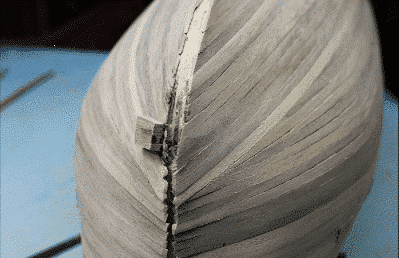
Learn The Art Of Building A Model Ship
Get started in wooden model ship building today








